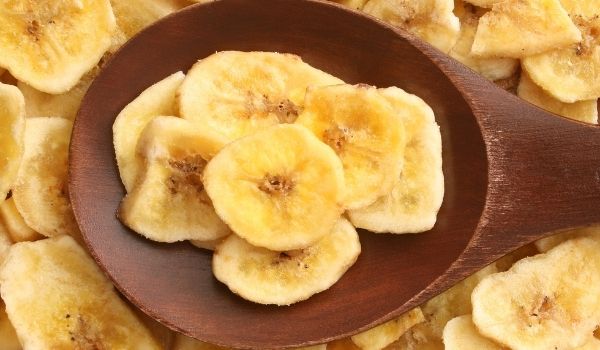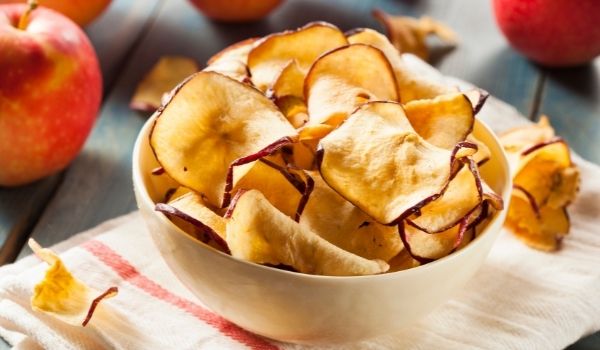One of the first questions I had before buying a home dehydrator is “what foods can be dehydrated?” and also “what foods cannot be dehydrated?” These are important questions for anyone who is interested in buying a home dehydrator to preserve their own food or for anyone who has recently bought a dehydrator and wants a list of ideas to get started. After a lot of research and personally trying a lot of different foods has helped me compile a large list of foods that are best to dehydrate and the few foods that don’t dehydrate well.
Many foods can be dehydrated for long-term storage including fruits, vegetables, meats, fish, fruit leather, jams, yogurt, sauces, herbs, syrup, honey, and even pet food. Dehydrating works by removing moisture (water) from foods, this means that oil-based or foods that are higher in fat don’t dehydrate well. Foods that cannot be dehydrated include avocados, milk, peanut butter, and butter.
We enjoy dehydrating our own food because it gives us control over exactly what we put in our food storage and into our snacks. To know exactly which food dehydrator is right for you check out my article Selecting the Best Food Dehydrator, Ultimate Buyers Guide.
We also enjoy preserving our food through freeze drying so we did a comparison between dehydrating and freeze-drying food. Check out our article Freeze Dried vs Dehydrated Foods: Complete Comparison.
Best Foods to Dehydrate for Long-term Storage and Snacks
- Fruits (home garden or store-bought)
- Vegetables (home garden or store-bought)
- Meats (Jerky, Beef, Chicken, and Fish)
- Jams/Applesauce (Fruit leather)
- Yogurt
- Sauces (Pizza, Spaghetti, BBQ, and more)
- Herbs
- Syrup & Honey
- Pet Food (Cat and Dog food)

It is also very helpful to consider what foods can and cannot be preserved through other methods such as freeze-drying and pressure canning. Also, see a complete list of foods that last a long time without refrigeration.
Fruits (home garden or store-bought)
Best fruits to dehydrate include:
- Bananas
- Apples
- Strawberries
- Mangos
- Pineapples
- Cherries
- Peaches
- Grapes
- Plums
- Pears
- Rhubarb
- Cranberries
- Raspberries
- Blueberries
- Blackberries
- Lemons
- Oranges
Vegetables (home garden or store-bought)
Best vegetables that to dehydrate include:
- Tomatoes
- Sweet Potatoes
- Zucchini
- Bell Peppers
- Peas
- Onions
- Carrots
- Squash
- Kale
- Potatoes
- Leafy Greens
- Mushrooms
- Broccoli
- Celery
- Corn
- Green Beans
- Pumpkin

Foods that tend to brown when they sit out such as apples, bananas, and pears can be lightly sprayed with lemon juice before you start to dry them. The light spray won’t change the flavor but it will maintain the color. If you don’t spray the food with lemon juice it will still taste fine, it will just have some discoloration.
Foods such as onions, carrots, and potatoes should be quickly blanched before starting the dehydrating process.
I always follow good preparation prior to dehydrating fruits and vegetables. Dehydrating doesn’t kill bacteria so only use healthy fruit and vegetables and clean them before putting them in a batch.
Peel and cut fruits and vegetables into evenly sized portions and lay them in one, even layer on the tray. Cutting fruit like grapes and blueberries is essential because they both have thick membranes that make it difficult for the water (moisture) to be released and also because they are high in sugar.
Meats (Jerky, Beef, Chicken, and Fish)
Best meats to dehydrate include:
- Jerky
- Ground beef
- Chicken
- Deli Meats
- Fish
Raw meat can be dehydrated if the meat reaches a temperature of at least 160 degrees Fahrenheit while then maintaining a temperature of 130-140 degrees Fahrenheit. HOWEVER, it must still go through an additional heat treatment before consumption such as being baked, fried, or grilled to an internal temperature of at least 160 degrees Fahrenheit to avoid foodborne illnesses.
To store dehydrated meat you’ll need an airtight container such as a glass jar, or mylar bag with an oxygen absorber, or other lidded airtight containers that will keep the meat completely air-free as any moisture encourages bacterial growth.
Jam/Applesauce (Fruit leather)
To make fruit leather you can use jams, apple sauce, or slightly overripe fruits. To get the flavor you want you can even mix any of these options or multiple fruits together. Honey is a common sweetener for fruit leather but a sweetener isn’t always needed.
TIP: Be careful not to over dehydrate when making fruit leather and spread as evenly as possible to avoid cracking.
Yogurt
Yogurt can be dehydrated in sheets or in small drops to make yogurt bites. Dehydrating yogurt can bring out the tangy flavor. If you prefer a sweeter yogurt, before starting the dehydrating process sweeten to taste with honey or maple syrup.
Sauces (Pizza, Spaghetti, BBQ, and more)
Sauces are very easy to dehydrate because they take very little prep work. Once the sauces are dehydrated, use a blender to turn them into powder. Dehydrated sauces also take up much less space on your shelves. One jar of spaghetti sauce once turned to a powder can measure to about 1 cup.
Common sauces that can be dehydrated include:
- Pizza Sauce
- Spaghetti Sauce
- Tomato Sauce
- BBQ Sauce
- Ketchup
- Mustard
- Alfredo Sauce
Herbs
Dehydrating herbs is super quick and easy. Herbs should be rinsed with cool water first then laid out in a single layer. Herbs can take anywhere from 1-4 hours at a temperature between 95°F-115°F. Dried herbs have a much longer shelf life and you can use dried herbs in place of fresh herbs in recipes
The most common herbs to dehydrate include:
- Basil
- Sage
- Mint
- Thyme
- Oregano
- Rosemary
Syrup & Honey
Dehydrating syrup eliminates the syrup crystallizing.
You can dehydrate many different types of syrup including:
- Maple syrup
- Corn syrup
- Agave Syrup
- Molasses
Dehydrating honey ensures an indefinite shelf life. Honey shouldn’t go bad. However, it can crystallize and change color. Dehydrating honey eliminates that happening and makes it easy to take on the go.
Dehydrator Temperature, Preparation, and Time of Foods that Can be Dehydrated
| Food to Dehydrate | Temperature | Preparation | Dryness Test | Time, Hours (approx.) |
|---|---|---|---|---|
| Apples | 135°F | Peel, core and cut into slices or rings | Pliable | 5-6 |
| Apricots | 135-140°F Slices175°F Half’s | Cut in half or in slices, remove the pit | Pliable | 12-38 |
| Bananas | 135°F | Peel and cut into 3-4mm slices | Crisp | 8-38 |
| Cherries | 165°F | Pitting is optional, or pit when 50% dry | Leathery | 8-34 |
| Cranberries | 115°F | Chop or leave whole | Pliable | 6-26 |
| Red Dates | 150°F | Pit and slice | Leathery | 6-26 |
| Figs | 140°F | Slice | Leathery | 6-26 |
| Grapes | 135°F | Leave whole | Pliable | 8-38 |
| Nectarines | 140°F | Cut in half, dry with skin side down. Pit when 50% dry | Pliable | 8-26 |
| Oranges/ Rind | 135°F | Peel in long strips | Brittle | 8-16 |
| Peaches | 135°F | Cut in half, dry with skin side down. Pit when 50% dry | Pliable | 10-34 |
| Pears | 130-140°F | Peel and slice | Pliable | 8-30 |
| Strawberries | 135°F | Cut into ⅜” slices, other berries whole | No moisture | 8-26 |
| Mango | 135-145°F | Remove skin, slice ⅜” thick | Leathery | 6-16 |
| Artichokes | 135°F | Cut into ⅓” strips. Boil about 10 minutes | Brittle | 6-14 |
| Asparagus | 140°F | Cut into 1” pieces | Brittle | 6-14 |
| Green Beans | 125°F | Cut and steam/blanch until translucent | Brittle | 8-26 |
| Beats | 125°F | Blanch, cool, remove tops and roots, slice | Brittle | 8-26 |
| Brussel Sprouts | 140°F | Cut sprouts from stalk, cut in half lengthwise | Crisp | 8-30 |
| Broccoli | 125°F | Trim and cut. Steam/blanch 3-5 minutes | Brittle | 6-20 |
| Cabbage | 140°F | Trim and cut into ⅛” strips. Cut core into ¼” strips | Leathery | 6-14 |
| Carrots | 125°F | Steam until tender. Shred or cut into slices | Leathery | 6-12 |
| Cauliflower | 140°F | Trim and cut. Steam/blanch 3-5 minutes. | Leathery | 6-16 |
| Celery | 135°F | Cut stalks into ¼” slices | Brittle | 6-14 |
| Chives | 95-125°F | Chop | Brittle | 6-10 |
| Cucumber | 135°F | Peel and cut into ½” slices | Leathery | 6-18 |
| Eggplant/Squash | 115-135°F | Trim and slice ¼” to ½” thick | Brittle | 6-18 |
| Garlic | 125°F | Remove skin from clove and slice | Brittle | 6-16 |
| Hot Peppers | 125-135°F | Dry whole | Leathery | 8-14 |
| Mushrooms | 110-120°F | Slice, chop, or dry whole | Leathery | 6-14 |
| Onions | 100-130°F | Slice thinly or chop | Brittle | 8-14 |
| Peas | 140°F | Blanch for 3-5 minutes | Brittle | 8-14 |
| Peppers | 125-135°F | Cut into ¼” strips or rings. Remove seeds | Brittle | 4-14 |
| Potatoes | 125°F | Slice, dice, or cut. Steam/blanch 8-10 minutes | Brittle | 6-8 |
| Rhubarb | 135°F | Remove outer skin and cut into ⅛” slices | No Moisture | 8-38 |
| Spinach | 125°F | Steam/blanch until wilted | Brittle | 6-16 |
| Tomatoes | 140°F | Remove skin. Cut in half or slices | Leathery | 8-24 |
| Zucchini | 120°F | Slice into ¼” slices | Brittle | 6-18 |
Dehydrating Tips and How-Tos

After you have dehydrated your food you should always condition them. Especially if you are planning on storing the food, not using it in the next few days as a snack or for something else.
Conditioning is when you put your cooled dehydrated foods in a glass jar to let sit. Shaking it once a day for 5 days to make sure there is no moisture and nothing is sticking to the sides, bottom, or together. If anything is sticking together or you can see moisture you’ll need to put everything back in the dehydrator and continue to dry.
If you see mold in any of your dehydrated foods, unfortunately, you will need to get rid of everything that is in that container. Mold colonies can start to grow before they are noticed. It is not worth the risk to just toss out the moldy part.
What Foods Cannot be Dehydrated?

Foods that don’t dehydrate well include:
- Avocados
- Olives
- Fatty Meats
- Dairy, Such as milk, butter, cheese due to the high risk of food poisoning
- Nuts
- Peanut Butter
- Sodas
- Juices
According to the National Center for Home Food Preservation (NCHFP) Milk, milk products, and eggs are not recommended for home drying because of the high risk of food poisoning. Commercially dried milk and egg products are processed rapidly at temperatures high enough to prevent bacterial contamination. Home dehydrators cannot duplicate this process, and the safety of home-dried milk and egg products cannot be guaranteed.
Foods that are higher in fat such as avocados, butter, nuts, and cheese will go rancid faster than they are able to dehydrate which makes them not a great option to dehydrate. These types of food often have an easily bought long-term storage option such as powdered cheese and butter. Another option for these items is to put them in the freezer.

